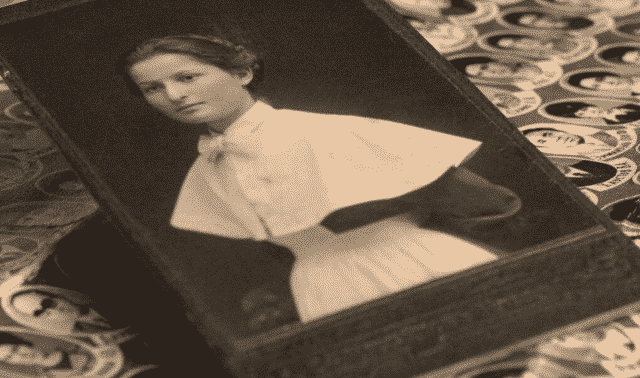Joanne Wallace owns copies of these undated portraits of her great-grandparents, Patrick Wallace and Sarah (Foley, or Folan) Wallace. She knows almost nothing about their lives in America and would like to learn more. Unfortunately, she lives in Hong Kong, which makes genealogical research possible only from a distance. All’s not lost, though: Here’s how she can tackle these photo mysteries.
First, Joanne asked me to identify her great-grandmother’s portrait, which she says has “a strange appearance as if it were a pencil drawing.” She wonders what type of photograph it is, as well as where and when it was taken. The type of image is known as a crayon portrait, a photograph enhanced by charcoal. (See my column “Wedding Album” for details on this method.) The image lacks a photographer’s imprint, so I can’t determine where it was taken based on photographic clues alone. However, dating the portrait was relatively easy. The woman’s full hair and dress style were in vogue between 1900 and 1910. Since Joanne’s great-grandparents were married June 27, 1911, this could be a wedding portrait, or a photo taken just before their wedding. The portrait of Joanne’s great-grandfather also falls within that time frame.
While researching her Wallace line, Joanne discovered that Patrick (born about 1883) and Sarah were Irish, and that they married in Boston. She doesn’t know when they immigrated to the United States. The marriage record, found in the Archdiocese of Boston’s archives, says “Sail for Ireland tomorrow” in the margin.
There are several steps Joanne can take to learn more about her great-grandparents:
- Search the newspapers for June 27, 1911, to see what ships left from Boston and where they were going. I’m not aware of any departure records for Boston, but having the ship’s name could be helpful later on.
-
If either of her great-grandparents was a US citizen, Joanne might find a passport application. She can order these records on microfilm from the National Archives and Records Administration (NARA) or from one of Hong Kong’s four Family History Centers (FHCs), branches of the Salt Lake City-based Family History Library.
-
Hire someone to search Boston city directories. These would reveal how long the couple lived in Boston before they were married. Establishing an approximate arrival date will help her find their passenger records, which she also can obtain from NARA and FHCs.
-
Contact the Archdiocese of Boston for additional information on the parish where they were married.
-
Search the 1910 federal census to see if the couple lived alone or with their parents/families. Once again, NARA and FHCs have these records on microfilm.
-
Contact The Irish Ancestral Research Association (TIARA) for a list of resources in the United States and Ireland.
These six steps should help answer the larger questions about this couple: why they left Ireland and when (and possibly why) they returned. For more tips on Irish research, I suggest Dwight A. Radford & Kyle J. Betit’s A Genealogist’s Guide to Discovering Your Irish Ancestors (Betterway Books, $19.99). Although living in Hong Kong restricts some of the research Joanne can do in person, she has plenty of other options—scouring Internet databases, hiring a professional researcher or borrowing microfilm. It’s only a matter of time before she cracks her ancestors’ codes.



